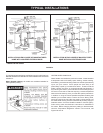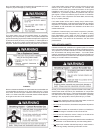
7
FACTS TO CONSIDER ABOUT THE LOCATION
This manufactured home gas-red water heater is for use in a
manufactured home. You should carefully choose an indoor location
for the new water heater, because the placement is a very important
consideration for the safety of the occupants in the building and for
the most economical use of the appliance. This water heater is
for use only in manufactured homes and is not intended for
outdoor installation.
The installation of this water heater must be within an enclosure
so as to separate the appliance combustion system and venting
system from the interior atmosphere of the manufactured home.
There shall not be any door, removable access panel, or other
opening into the enclosure from the inside of the manufactured
home.
Whether replacing an old water heater or putting the water heater in
a new location, the following critical points must be observed.
1. An enclosure with an exterior access door incorporating a single
opening positioned a maximum of 6 inches above the lower edge
of the access door and which may incorporate either 1/4 inch wire
mesh or louvers. When 1/4 inch wire mesh is used, the size of
the opening must be a minimum of 20 square inches. When the
louvers are used, the free area must be a minimum of 20 square
inches, see Figure 2 page 6.
2. An optional enclosure incorporating a solid exterior access door,
when a 5 inch or 8 inch diameter, or 20 square inch minimum
equivalent free air opening is located in the oor of the enclosure.
The opening must be covered by a 1/4 inch wire mesh, see Figure
2 page 6.
Install water heater into closet so as to have 0 inches minimum
clearance at sides and back. Clearance of 4 inches is needed to
front to accommodate the gas control valve, see Figure 3. Be sure
to allow adequate clearance for servicing the water heater and for
access to the piping and temperature-pressure relief valve.
The water heater should be secured to the oor and to the wall of the
enclosure with the mounting brackets provided. For bracket location
refer to “Securing Water Heater to Floor and Wall” in the “Installing
the New Water Heater” section.
When a manufactured home is skirted, an air intake opening with a
minimum free area of 32 square inches must be provided in the skirt.
Other gas red appliances in the home will require additional free air
openings; consult these manufacturers for correct sizing.
If the opening is covered by louvers or screen, the total free area
must be 32 square inches.
Installation of the water heater must be accomplished in such a
manner that if the tank or any connections should leak, the ow
will not cause damage to the structure. For this reason, it is not
advisable to install the water heater in an attic or upper oor. When
LOCATING THE NEW WATER HEATER
such locations cannot be avoided, a suitable drain pan should be
installed under the water heater. Drain pans are available at your
local hardware store. Such a drain pan must have a minimum length
and width of at least 2 inches (51 mm) greater that the water heater
dimensions and must be piped to an adequate drain. The pan must
not restrict combustion air ow.
Water heater life depends upon water quality, water pressure and
the environment in which the water heater is installed. Water heaters
are sometimes installed in locations where leakage may result in
property damage, even with the use of a drain pan piped to a drain.
However, unanticipated damage can be reduced or prevented by
a leak detector or water shut-off device used in conjunction with a
piped drain pan. These devices are available from some plumbing
supply wholesalers and retailers, and detect and react to leakage
in various ways:
• S
ensors mounted in the drain pan that trigger an alarm or turn off the
incoming water to the water heater when leakage is detected.
• Sensors mounted in the drain pan that turn off the water supply
to the entire home when water is detected in the drain pan.
• Water supply shut-off devices that activate based on the water
pressure differential between the cold water and hot water pipes
connected to the water heater.
• Devices that will turn off the gas supply to a gas water heater
while at the same time shutting off its water supply.
INSTALLATIONS IN AREAS WHERE FLAMMABLE LIQUIDS
(VAPORS) ARE LIKELY TO BE PRESENT OR STORED
(GARAGES, STORAGE AND UTILITY AREAS, ETC.): Flammable
liquids (such as gasoline, solvents, propane [LP or butane, etc.] and
other substances such as adhesives, etc.) emit ammable vapors
which can be ignited by a gas water heater’s pilot light or main burner.
The resulting ashback and re can cause death or serious burns to
anyone in the area. Even though this water heater is a ammable
vapors ignition resistant water heater and is designed to reduce
the chances of ammable vapors being ignited, gasoline and other
ammable substances should never be stored or used in the same
vicinity or area containing a gas water heater or other open ame
or spark producing appliance.


















